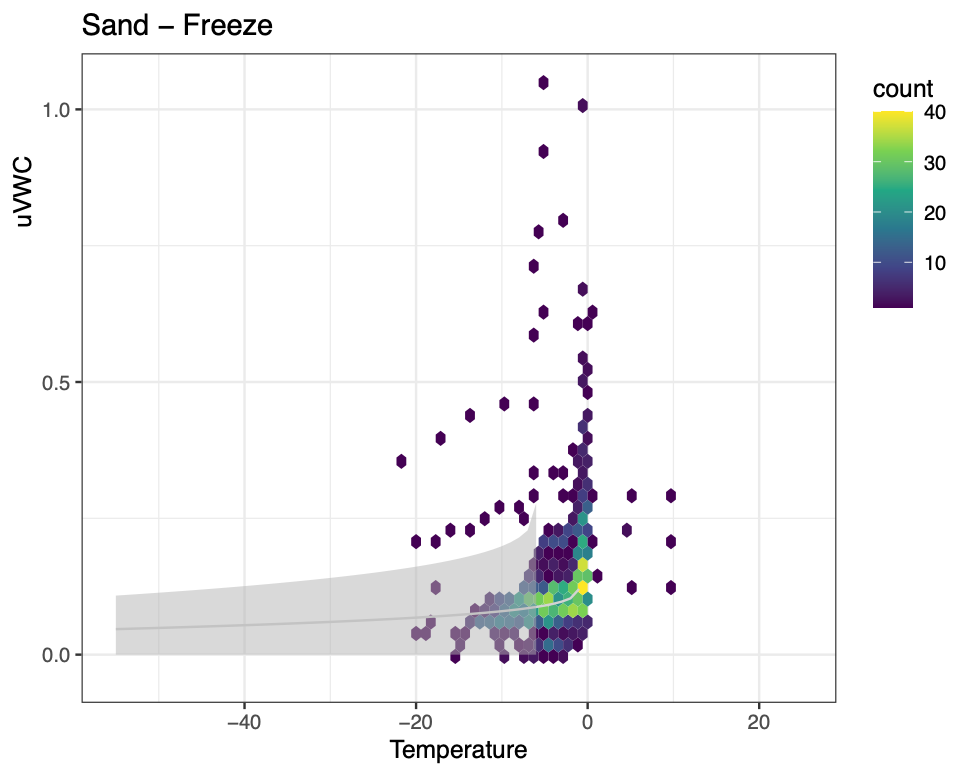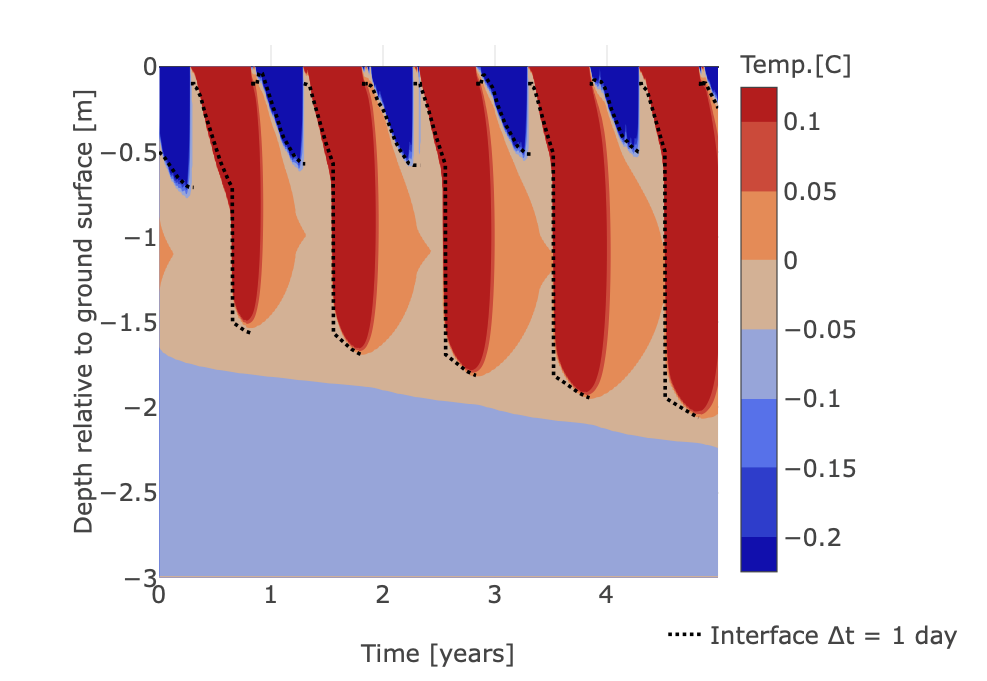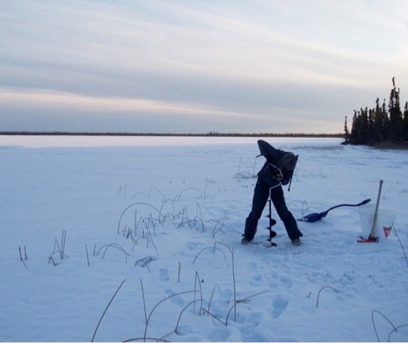
My research projects help to address the following UN Sustainable Development Goals:
I focus on responsible and productive ways to study hydrology and hydrogeology in cold regions. I am particularly interested in climate change in permafrost environments and improving our predictive capacity through combining modelling and fieldwork. I bring together the worlds of modelling and fieldwork to try to solve real-world problems facing people who live in Canada’s North.
Education
|
2021 |
Doctor of Philosophy |
University of Waterloo |
|
2015 |
Bachelor of Mathematics |
University of Waterloo |
Selected Awards
|
2021 |
Water Resources Research Editor’s Choice Award: "A semianalytical interface model of soil freeze/thaw and permafrost evolution” |
|
2021 |
NSERC Postdoctoral Fellowship |
|
2018 |
NSERC Canadian Graduate Scholarship – Doctoral |
|
2017 |
NSERC Canadian Graduate Scholarship – Master’s |
Academic Experience
|
2023 - Present |
Assistant Professor |
|
2021 - 2022 |
Postdoctoral Research Fellow |
Bringing together the worlds of numerical modelling, community engagement, fieldwork, and laboratory analysis to solve real-world problems facing people who live in Canada’s warming North.
Engineering Sustainable Change
Permafrost is ground (soil or rock) that is at or below 0˚ C for two or more consecutive years. Anthropogenic climate change is driving cold regions to warm at up to four times the average global rate, resulting in widespread permafrost thaw. This has important implications for how water moves and is stored in these landscapes, impacting everything from the structural properties of soils to the water quality in lakes, rivers, and wetlands. Given the rapid change observed by Indigenous communities in their traditional Northern territories, predicting changes and developing adaptation and mitigation strategies is key to the sustainable future of the North.
Dr. Élise Devoie, Research Chair in Collaborative Research for a Sustainable North, is focussed on responsible and productive ways to study hydrology and hydrogeology in cold regions. Their work addresses the question: How is climate change impacting frozen soils, and what are complex way these changes are felt? This question is especially important to communities directly affected by permafrost thaw, and community priorities drive Dr. Devoie’s research objectives. These objectives are largely transdisciplinary, convening teams of experts, including Indigenous community members, to improve our predictions of the impacts of climate change in permafrost environments.
 |
Is Permafrost Frozen? This question is especially important to communities directly affected by permafrost thaw, and community engagement is an important pillar of my research. I work to make sure that the research problems I am trying to solve align with community priorities. My research is unique because it bridges disciplines. I use a combination of field data collection, laboratory investigation, and numerical modelling to try to understand observed changes and make predictions for the future. Some of my favourite research questions come from bringing together disciplines that are usually separate. |
 |
Is there a better way to model freeze/thaw? The freeze/thaw process is notoriously difficult to model because it is not mathematically ‘smooth’. When we include it in our models, we do get hugely improved results, but it also often causes them to slow down by up to 100x, or just straight up crash! I’m working on some semi-analytical techniques to speed up models including freeze/thaw and improve model performance. After all, it is not just permafrost systems that need this type of model, but also anywhere the ground freezes! |
 |
How does permafrost thaw affect water resources? Intuitively it is clear that the loss of permafrost will have strong implications for every aspect of permafrost landscapes. But what shape will this change take? I conduct field investigations to measure the changes that are being observed, and to understand the implications they are having on the way water moves and is stored in the landscape.
|
For an up-to-date record, please consult my Google Scholar page.
Selected Publications
Devoie, É. G., Gruber S. & McKenzie J. (2022). A repository of measured soil freezing characteristic curves: 1921 to 2021. Earth Systems Science Data, 14, 3365–3377.
Devoie, É. G., Craig, J. R., Dominico, M., Carpino, O., Connon, R. F., Rudy, A. C., & Quinton, W. L. (2021). Mechanisms of Discontinuous Permafrost Thaw in Peatlands. Journal of Geophysical Research: Earth Surface, 126(11).
Devoie, É. G., Connon, R. F., Craig, J. R., & Quinton, W. L. (2020). Subsurface flow measurements using passive flux meters in variably-saturated cold-regions landscapes. Hydrological Processes, 34(23), 4541-4546.
Devoie, É. G., & Craig, J. R. (2020). A semianalytical interface model of soil freeze/thaw and permafrost evolution. Water Resources Research, 56(8).
Devoie, É. G., Craig, J. R., Connon, R. F., & Quinton, W. L. (2019). Taliks: A tipping point in discontinuous permafrost degradation in peatlands. Water Resources Research, 55(11), 9838-9857.
I am always looking for curious and motivated students who are interested in climate change research in cold regions. If this is you, especially if you have an exciting project idea, please send me a cover letter, CV, and transcript with the subject line “Climate Change Graduate Research at Queen’s”.
Right now, my group has the following openings:
PhD student (Start Summer/Fall 2025):
Current large-scale permafrost models represent soils using a binary frozen/thawed state, lacking rigorous representation of soil freezing through representative soil freezing characteristic curves (SFCCs). To accurately quantify the ice content of frozen and partially frozen soils in large-scale models, you will derive an extension to a semi-analytical interface model to include partially frozen soils and make it into an ArcMap toolbox, run the model using Canadian weather station data, the surficial geology map of Canada, the Ground Ice Map of Canada, and the National Soils Database to define the SFCC. The model will be validated against data collected in the field in three permafrost sites in collaboration with the Guardian program in each region (Indigenous partners in climate change research and monitoring). Current permafrost maps do not include SFCCs, or segregated ground ice and consequently significantly misrepresent ice content. GIS experience required.
PhD student (Start Summer 2025):
Members of the community of Whatì, NWT, belonging to the Tłı̨chǫ nation, have reported changes to the quality and health of the fish they rely on. To understand what is driving these changes, we have put together an interdisciplinary team of researchers including biologists, geochemists, hydrogeologists, hydrologists, to study two small lake catchments: one burned and one unaffected by wildfire. In this role, you will quantify water and energy balances for each lake using field data (streamflow and groundwater, environmental tracers, precipitation, net radiation) and model each catchment with the Raven hydrological framework. The model will be validated against data collected in the field. All field data will be collected with Tłı̨chǫ Environmental monitors who will provide key insights into site selection and contextual understanding. Results from this work will inform fish habitat modelling and change detection. Field experience required.
MSc student (Start Summer/Fall 2025):
The Raven Hydrological Modelling Framework is widely used in Canada for flood forecasting, regulating hydroelectric power generation, and other water management activities, but it does not currently explicitly represent soil freeze/thaw processes. In a changing climate, an integrated representation of freeze/thaw processes is critical for the representation of midwinter melt events, rain-on-snow, and other winter flooding triggers. Your role will be to test the implementation of a semi-analytical interface model of freeze/thaw in Raven, identify model improvements, and generate the first fully integrated freezing hydrologic model directly representing permafrost evolution. You will then apply the model to the La Martre catchment in the NWT to validate the model representation and contribute to understanding the cumulative impacts of climate change on this basin.
To find out more on how to apply to graduate school at Queen’s University, please find the link here.